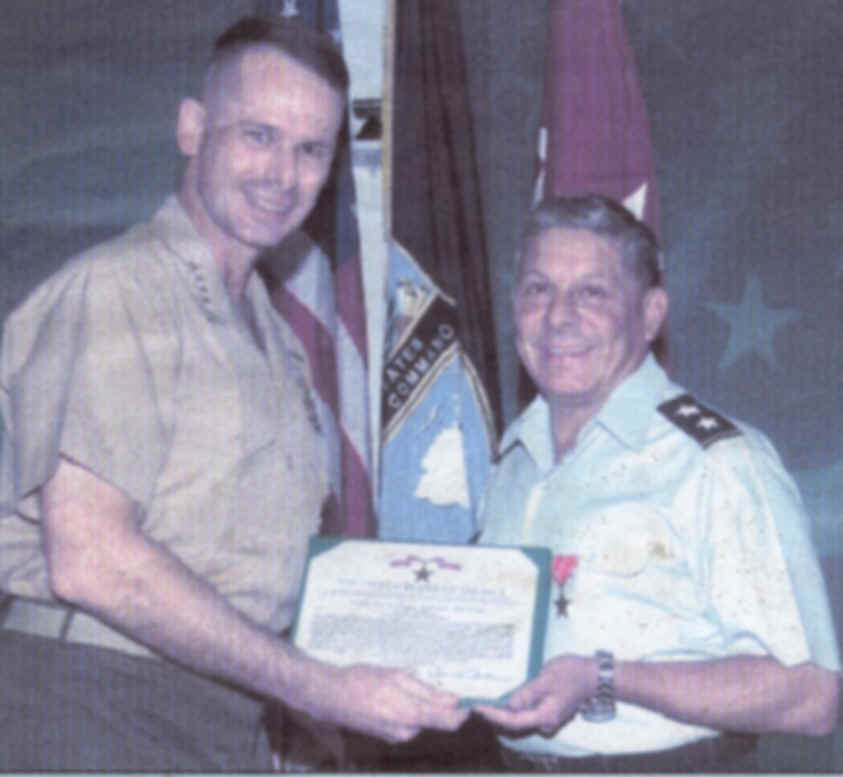|
|
Former
Southern Command Commander
GENERAL PETER
PACE FIRST MARINE AS CHAIRMAN OF JOINT CHIEFS OF STAFF
 |
General Peter Pace,
succeeded Air Force General Richard B. Myers on September 30,
2005, as chairman of the Joint Chiefs of
Staff when Myers stepped down to retire. The 16th Joint Chiefs
chairman, Pace is the
first Marine to serve in that position which is the senior
military adviser to the President, the Secretary of Defense, and the National Security
Council -- thus the Nation's highest ranking military officer.
Before becoming Vice Chairman of the Joints
Chiefs of Staff in October 2001 (another first for a Marine), Pace commanded the U.S. Southern Command in Miami September
8, 2000 until September 30, 2001.
|
| General
Peter Pace 16th Chairman of the Joint Chiefs of Staff |
 |
| While
Commander of U.S. Southern Command in Miami, General Pace presented
the Bronze Star Medal (with "V" device) to Major
General Alfred A. Valenzuela, then U.S. Army South commander,
April 2, 2001, for his actions April 13, 1884, as a major,
in protecting El Salvadoran election officials against an
automatic fire and grenade attack by guerrillas during the
national elections. [Photo by Army Spc.Lucy J. Pabon,
SouthCom's Command Run newspaper] |
A 1967 graduate of the U.S. Naval Academy, Pace began his
military career as a platoon leader in Vietnam at the Battle of
Hue City in 1968. Since then he has commanded at every level in
the Marine Corps in the United States, Thailand, and Korea and
with joint forces.
Since his promotion to brigadier general in 1992, Pace served
in the United States, Somalia (as deputy commander, Marine Forces,
Somalia, Dec.1992 - Feb. 1993 and deputy commander, Joint Task
Force-Somalia Oct. 1993 - March 1994) and Japan before becoming
the director for operations on the Joint Staff in 1996. In
1997-Sept. 2000, he was commander, U. S. Marine Corps Forces,
Atlantic/Europe/South.
He also holds a Master's Degree in Business Administration from
George Washington University and attended Harvard University for
the Senior Executives in National and International Security
program and earlier the Marine Corps Command and Staff College and
the National War College in Washington, D. C.
Navy Admiral Edmund Giambastiani Jr.
became Vice Chairman of the Joint Chiefs of Staff in August 12,
2005, succeeding General Pace.
Giambastiani previously served as the commander of U.S. Joint
Forces Command and as NATO's Supreme Allied Commander
Transformation.
(General Pace's biography at http://www.defenselink.mil/bios/pace_bio.html) Below
is General Pace's initial guidance to the Joint Staff.

Pace Issues Guidance to
Help Military 'Shape the Future'
By Jim Garamone
American Forces Press Service |
| WASHINGTON,
Oct. 3, 2005
–
The war on terror underlies every word in the Chairman's
Guidance to the Joint Staff. Marine
Gen. Peter Pace, who took office as the 16th Joint Chiefs
chairman on Sept. 30, issued the guidance so members of
the Joint Staff would understand his priorities and focus
on what he considers important in the coming years, said
defense officials.
Pace reiterates in a number
of places in the guidance that he considers the war on
terror to be winnable, but will be "a war of long
duration. "
Pace's guidance is
subtitled "Shaping the Future. " He said that
while the emphasis must be on the war on terror, the U. S.
military must be ready for any eventuality.
Pace's priorities are
concise and mutually supporting. At the top is winning the
war on terror.
"Our enemies are
violent extremists who would deny us, and all mankind, the
freedom to choose our own destiny," Pace wrote in the
guidance. "Finding this distributed, loosely
networked enemy is the greatest challenge we face. "
The U. S. will meet and
beat the enemy on the battlefield, but that is not enough,
he said. Building better economies, encouraging good
government and assisting governments as they live by the
rule of law will help the world shape "an environment
that precludes the flourishing of terrorism, much as a
healthy body rejects the onslaught of disease. "
The United States must
harness all elements of national and international power
to stop terrorists and stop young people from wanting to
join jihadist organizations. "My military advice to
our nation's leaders will favor recommendations that
integrate and coordinate our efforts with the work of
others fighting this war," Pace wrote. "Through
closer coordination within the Department of Defense and
interagency (cooperation) we maximize the impact of our
military power and build trust, synergy and momentum.
"
His second priority is to
speed up transformation processes within the military.
Changing the old mindset is the most important aspect of
this change. He wrote that at its heart, transformation
"is a willingness on the part of the individual and
the organization to embrace innovation and accept analyzed
risk. "
His third priority is to
strengthen joint-warfighting capability. He said the U. S.
military must transition "from an interoperable to an
interdependent force. " The fights in Afghanistan and
Iraq have been more joint than any before, officials said.
Still, much more can - and must be - done.
Pace said this move toward
jointness does not mean a diminution of the service
cultures. "I want you to bring your service
perspective to the decision process," he wrote. The
strength of this staff, like the strength of the nation,
lies in the articulation of multiple views. Individual
service perspectives brought together jointly, foster
better solutions, which we then execute in a joint
framework. "
His final priority is to
improve the quality of life for servicemembers and their
families. "Bringing our people home alive and intact
is Quality of Life Job No. 1," he wrote. "The
best leadership, the most innovative tactics, the best
equipment and the best force protection are indispensable
to this goal. "
|
|
Site
developed, owned and maintained by
William H.
Ormsbee, Jr.
2005
|